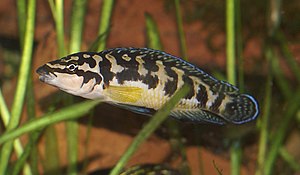Julidochromis
| Julidochromis | ||||||||||||
|---|---|---|---|---|---|---|---|---|---|---|---|---|

|
||||||||||||
| Systematics | ||||||||||||
|
||||||||||||
| Scientific name | ||||||||||||
| Julidochromis | ||||||||||||
| Boulenger , 1898 |
Julidochromis is a genus from the family of cichlids (Cichlidae), which is endemic in Lake Tanganyika and lives there in the rocky zone. Six species belong to the genus. The genus name refers to the wrasse genus Julis , whichresembles Julidochromis in shape and teeth.
features
Julidochromis species have an elongated, cylindrical body and a relatively small head. The belly line is almost straight, the back line slightly arched. The soft rayed part of the dorsal and anal fin and the pelvic fins are pointed, the caudal fin rounded. Three species are 8 to 10 cm long, the other three reach lengths of about 12 to 15 cm ( J. marlieri , J. marksmithi and J. regani ). In these, older males develop a forehead hump. In some species, the females grow larger than the males. Characteristic of the genus is the non-ossified suborbitalia (bones below the eye socket) and the long dorsal fin supported by numerous spines (XXI-XXIV). All Julidochromis species have a yellow base color and have dark vertical stripes or a dark grid pattern.
Way of life
Julidochromis species live very close to rocky biotopes and form territories there , which they defend vigorously against conspecifics or other cichlids. The eggs are laid in a cave or narrow crevice, 20 to 50 in the three smaller species, up to 100 in the larger ones. The fry hatch after two to three days and swim free after five days. You are protected by both parents ( parent family ).
species
- Dickfeld's slim cichlid ( Julidochromis dickfeldi Staeck, 1975)
- Julidochromis marksmithi Burgess, 2014
- Checkerboard slim cichlid ( Julidochromis marlieri Poll, 1956)
- Yellow slim cichlid ( Julidochromis ornatus Boulgenger, 1898), type species
- Four-striped slender cichlid ( Julidochromis regani Poll, 1942)
- Black and white slim cichlid ( Julidochromis transcriptus Matthes, 1959)
Systematics
The genus Julidochromis was in 1898 by the Belgian-British ichthyologist George Albert Boulenger along with the type species Julidochromis ornatus first described . The genus is probably not monophyletic , i.e. does not form a family group that contains all descendants of the youngest common ancestor. Rather, DNA comparisons suggest that the small Julidochromis species ( J. dickfeldi , J. ornatus and J. transcriptus ) are more closely related to the genus Chalinochromis than to the large Julidochromis species. The latter are closely related to Neolamprologus walteri . The genus Julidochromis is therefore polyphyletic, the genus Chalinochromis is therefore paraphyletic. The characteristic phenotype of the genus Julidochromis probably arose twice in the course of a convergent evolution .
Aquaristics
Julidochromis species are common aquarium fish, as they can be kept in smaller aquariums due to their small size (for Tanganyika perch ratios).
literature
- Günther Sterba : The world's freshwater fish. 2nd Edition. Urania, Leipzig / Jena / Berlin 1990, ISBN 3-332-00109-4 .
- Günther Sterba (Ed.), Gert Brückner: Encyclopedia of Aquaristics and Special Ichthyology. Neumann-Neudamm, Melsungen u. a. 1978, ISBN 3-7888-0252-9 .
- Georg Zurlo: Julidochromis. In: Claus Schaefer, Torsten Schröer (Hrsg.): The large lexicon of aquaristics. Eugen Ulmer, Stuttgart 2004, ISBN 3-8001-7497-9 , pp. 528-530.
Individual evidence
- ↑ Christian Sturmbauer, Walter Salzburger, Nina Duftner, Robert Schelly, Stephan Koblmüller: Evolutionary history of the Lake Tanganyika cichlid tribe Lamprologini (Teleostei: Perciformes) derived from mitochondrial and nuclear DNA data. Molecular Phylogenetics and Evolution 57 (2010) 266-284, doi: 10.1016 / j.ympev.2010.06.018
Web links
- Julidochromis on Fishbase.org (English)
